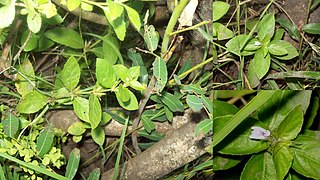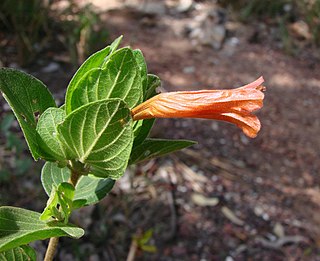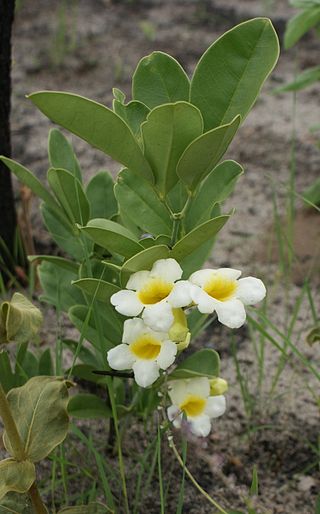
Carl Friedrich Philipp von Martius was a German botanist and explorer. Between 1817 and 1820, he travelled 10,000 km through Brazil while collecting botanical specimens. His most important work was a comprehensive flora of Brazil, Flora Brasiliensis, which he initiated in 1840 and was completed posthumously in 1906.

August Wilhelm Eichler, also known under his Latinized name, Augustus Guilielmus Eichler, was a German botanist who developed a new system of classification of plants to reflect the concept of evolution. His author abbreviation in botany is Eichler.

Ruellia is a genus of flowering plants commonly known as ruellias or wild petunias. They are not closely related to petunias (Petunia) although both genera belong to the same euasterid clade. The genus was named in honor of Jean Ruelle (1474–1537), herbalist and physician to Francis I of France and translator of several works of Dioscorides.
Ruellia verbasciformis is a species of flowering plant native to the Cerrado vegetation of Brazil. It is endemic to west-central Brazil. This plant is cited in Flora Brasiliensis by Carl Friedrich Philipp von Martius.

Hygrophila costata, with the common names glush weed, gulf swampweed, and yerba de hicotea, is an aquatic plant.
Stenandrium pohlii, with Portuguese common names caiapiá or carapiá, is a species of flowering plant in the family Acanthaceae. It is a perennial native to Bolivia, Paraguay, and western, southeastern, and southern Brazil. It is native to Cerrado and Pantanal ecoregions of Brazil. The description of the plant was published in Flora Brasiliensis in 1847.
Ruellia hypericoides is a species of flowering plant native to southern Paraguay, southern Brazil, northeastern Argentina, and Uruguay. This plant is cited in Flora Brasiliensis by Carl Friedrich Philipp von Martius.

Ruellia villosa is a species of flowering plant native to the Cerrado ecoregion of central and eastern Brazil. This plant is cited in Flora Brasiliensis by Carl Friedrich Philipp von Martius.
Ruellia menthoides is a species of flowering plant native to northern, eastern, and central Brazil, Bolivia, Peru, and Venezuela. In Brazil it grows in the Cerrado ecoregion. This plant is cited in Flora Brasiliensis by Carl Friedrich Philipp von Martius.
Ruellia pohlii is a plant native to Goias state in the Cerrado ecoregion of west-central Brazil. This plant is cited in Flora Brasiliensis by Carl Friedrich Philipp von Martius.

Ruellia macrantha, or Christmas pride, is a species of flowering plant native to the cerrado vegetation of Brazil. It is often used as an ornamental plant. This plant is cited in Flora Brasiliensis by Carl Friedrich Philipp von Martius.
Ruellia angustior is a plant native of Cerrado vegetation of western Brazil. This plant is cited in Flora Brasiliensis by Carl Friedrich Philipp von Martius.

Astronium fraxinifolium is a timber tree, which is native to Amazon Rainforest, Atlantic Forest, Caatinga, and Cerrado vegetation in Brazil. Common names include kingwood, locustwood, tigerwood, and zebrawood. It is known in Portuguese as Gonçalo-alves. This plant is cited in Flora Brasiliensis by Carl Friedrich Philipp von Martius. It is also used to make hardwood such as tigerwood.

Aspidosperma cylindrocarpon is a timber tree native to Brazil, Paraguay, Bolivia, and Peru. It is common in Atlantic Forest, Cerrado and Pantanal vegetation of Brazil. This plant is cited in Flora Brasiliensis by Carl Friedrich Philipp von Martius. In addition, it is useful for beekeeping.

Aspidosperma parvifolium is a timber tree native to Brazil, which is typical of Atlantic Forest, Cerrado, Caatinga, and Pantanal vegetation. This plant is cited in Flora Brasiliensis by Carl Friedrich Philipp von Martius. In addition, it is useful for beekeeping.

Aristolochia gigantea, the Brazilian Dutchman's pipe or giant pelican flower, is an ornamental plant native to Brazil, Costa Rica and Panama. Typical of subtropical Bahia and Minas Gerais vegetation, it is a vigorous evergreen climber (vine) with cordate heart-shaped leaves and spectacular fragrant flowers. This plant is cited in Flora Brasiliensis by Carl Friedrich Philipp von Martius. A. gigantea and other tropical Dutchman's pipe varieties pose a threat to the pipevine swallowtail butterfly. The butterfly confuses A. gigantea with its native host plant and will lay eggs on it although pipevine swallowtail caterpillars cannot survive on the foliage because the leaves are toxic to the larvae.

Anemopaegma glaucum is a plant native to Caatinga and Cerrado vegetation in Brazil. This plant is cited in Flora Brasiliensis by Carl Friedrich Philipp von Martius.
Triplachne is a genus of seaside plants in the grass family, native to shorelines in the Mediterranean region from the Canary Islands to Turkey. The only known species is Triplachne nitens, called shining grass. It is native to Spain, Portugal, Sicily, Greece, Algeria, Morocco, Libya, Tunisia, Egypt, Turkey, Cyprus, Palestine, Israel.











